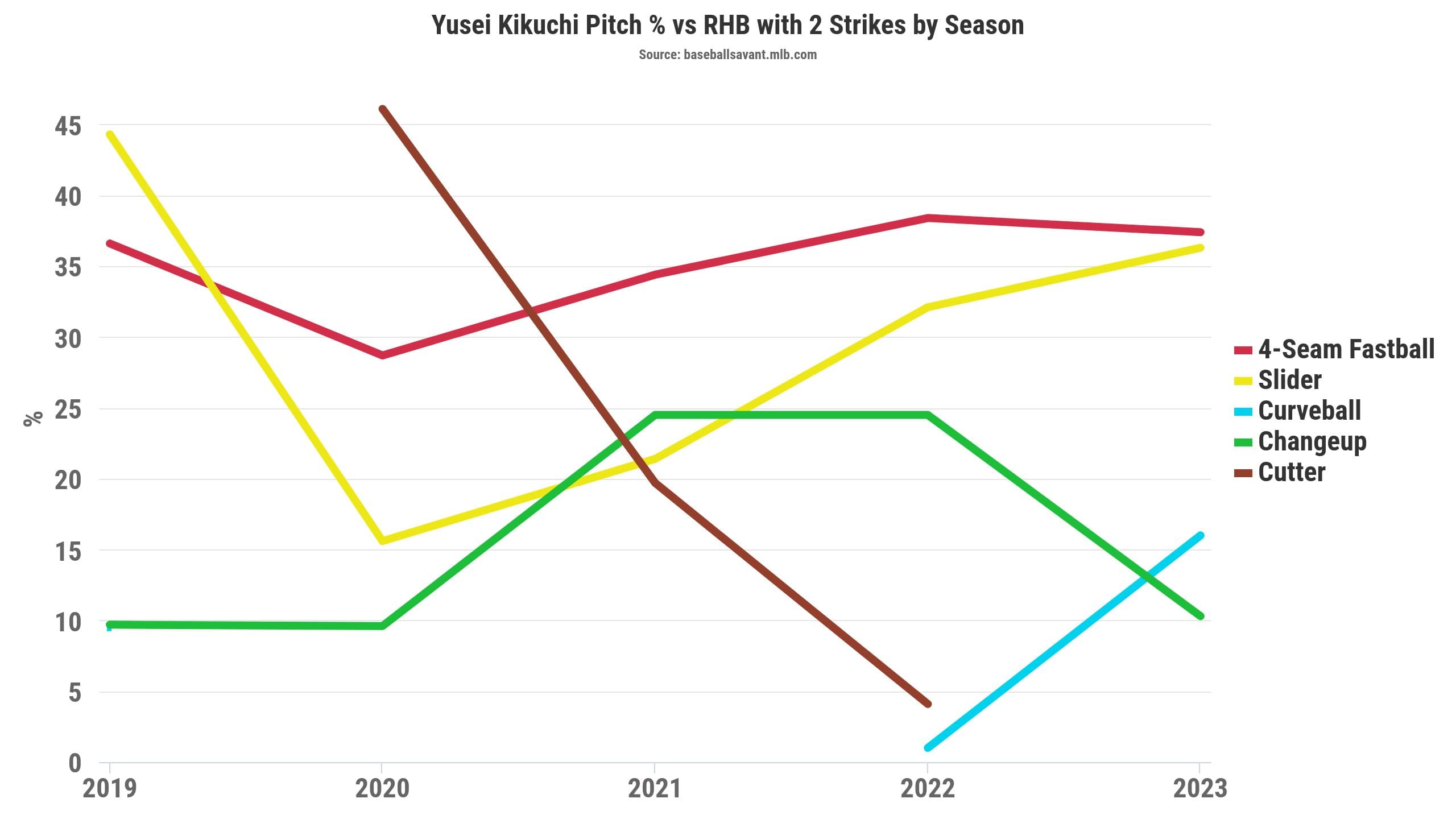Yusei Kikuchi, new changeup grip
Exploring the potential upside of Yusei Kikuchi’s new-look changeup

Photo credit: Nathan Ray Seebeck-USA TODAY Sports
By Thomas Hall
Mar 12, 2024, 15:30 EDT
Safe from competing for a rotation spot this spring, Yusei Kikuchi is focused on sustaining last season’s impressive bounce-back, where he posted career bests across the board, including a 3.86 ERA. Perhaps there’s even another level to reach, one he could unlock by debuting a few new tricks this season to keep the opposition on its toes.
Among those involves a new addition to Kikuchi’s arsenal, as the Toronto Blue Jays hurler has been experimenting with a sweeper this spring, a separate offering to his cutter-slider hybrid. It’s still in the early stages of development, though, so don’t expect to see him using his fifth pitch very often, or at all, during Grapefruit League action.
In all likelihood, that offering won’t impact Kikuchi’s 2024 season. However, one pitch he’s hoping will become a difference-maker is a weapon that, historically, has proven inconsistent over the years – his changeup.
Since arriving in North America in 2019, the 32-year-old’s off-speed offering has been unreliable from season to season. It might be effective one year but then unreliable the next. But when it’s on, it can be one of his most lethal swing-and-miss tools, pairing well with his explosive fastball from the left side.
That trend sums up the left-hander’s changeup over his first two seasons with the Blue Jays. In 2022, it was his most effective weapon, statistically speaking, at least, posting the highest run value (four), strikeout (42.9 per cent) and whiff rates (39.6 per cent) of his arsenal. He only threw it 13.4 per cent of the time, exclusively against righties, but it was virtually untouchable in small doses.
Then came last season, which was a year to forget for Kikuchi’s changeup. Its usage dropped below 10 per cent while opponents slugged .517 against it just one season after registering a .188 clip. If that weren’t enough, it also produced a minus-four run value, plus sub-20-per-cent strikeout and whiff rates.
So, after it transitioned to his fourth pitch, surpassed by his new-and-improved curveball, Kikuchi returned to the drawing board and made some tweaks over the winter. Upon arriving to spring training, it featured a few notable differences – among them was a new grip, shifting from his previous split-finger-type position to a spike grip.
Adjusting where his fingers rest on the ball has allowed Kikuchi to reduce the amount of spin his changeup generates, with its average spin rate decreasing from 1,724 RPMs in 2023 to 1,469 over two starts this spring. But you’re probably thinking, “Wait, wouldn’t he want to increase that figure rather than lower it?” In most cases, yes, except for this one.
Normally, the more spin a pitch creates, the better. While that’s the goal for some pitchers with elite changeups, such as Trevor Richards and Devin Williams, most off-speed pitches – including splitters – are more effective with the least amount of axis spin possible.
Kikuchi is no different, considering his changeup has enjoyed more success with an average spin rate of 1,600 RPMs or less compared to one exceeding 1,700. But that isn’t the only reason it’s displayed reason for optimism in camp.
Velocity, or a lack thereof, has also been a notable difference from years past. Outside of 2019, Kikuchi’s changeup has mostly sat in the 86-87 m.p.h. range, topping out with an average of 88.7 last season. The only problem was his slider produced an identical figure, causing the two to bleed into each other.
The hard-throwing lefty needed to create additional separation between his main two offerings – four-seamer and slider – and his changeup, and that’s precisely what he’s done this spring. Now, with it averaging 84.8 m.p.h., he’s provided himself with a fourth change-of-pace weapon different from his mid-90s heater, high-80s slider and low-to-mid 80s curveball.
These changes have also impacted its movements, both vertically and horizontally. Starting with its north-south approach, it has added nearly four inches of downward break from its 2023 average (27.4), which would be a career-high over a full season. That’d also be true for its horizontal break, as it features three additional inches on average compared to last season’s mark (9.1).
Granted, this is only a tiny sample size derived from a two-game stint, during which Kikuchi only threw 13 changeups. So, it’s wise to reserve some judgment for later this spring. Still, it’s difficult not to feel encouraged by his refined process.
But that feeling will undoubtedly intensify after you examine the early results.
Thus far, his changeup has induced three of his eight strikeouts, registering four swinging strikes on just seven swings – all versus right-handed batters. All you need to realize its potential is to witness how well it tunnels off his four-seamer – something Pittsburgh Pirates hitters learned the hard way in his Grapefruit League debut.
Yusei Kikuchi, 95mph Fastball and 85mph Changeup, Overlay
As a secondary offering, the success of Kikuchi’s changeup will largely be determined by whether he can improve his fastball command versus righties, with his goal to have fewer instances where it misses over the heart of the plate. Instead, he’ll aim to have those pitches finish near the top of the zone, ideally on the inner half, to help avoid opponents’ barrels.
That should help the Japanese hurler attack each quadrant of the strike zone more effectively this season, at least in theory. He can use his four-seamer in the upper third and his slider on the inner half, while his curveball and changeup cover the bottom third and outer half sections.
Knowing when to throw a pitch is often as important as where it finishes. For Kikuchi, that’ll mean increasing his changeup’s usage versus right-handers, particularly during two-strike counts, after he used it only 10.3 per cent of the time in 2023 – a dramatic decline from its deployment across 2021-22.

Source: Baseball Savant
The veteran lefty fell in love, probably a little too much, with his fastball-slider combo in these spots, as their usages each surpassed 35 per cent. But it’s hard to blame him, given how effective that duo was. However, considering his curveball allowed a .327 SLG, the highest of his four pitches, he could certainly benefit from making a change.
With the tweaks made to his changeup, the makings are there for it to become a more prominent weapon in 2024, which should also improve the rest of his arsenal as he looks to take another step forward in controlling bat speed.
Not only could it lead to increased swing-and-miss, but it also has the potential to neutralize the success righties enjoyed against him last season, where they slashed .266/.321/.435 and clubbed 21 of his 27 home runs surrendered. And it could mitigate a bit of the negative regression that might occur, too.
Since Kikuchi will hit free agency after this season, there’s no better time than the present to prove last season’s growth was more than just a one-off.
ARTICLE PRESENTED BY BETANO

Breaking News
- What signing Bichette or Tucker could mean for Blue Jays’ position-player group
- Blue Jays: Trey Yesavage ranks in early Rookie of the Year poll
- Guardians trade former Blue Jay Justin Bruihl to Cardinals
- Report: Yankees presented Cody Bellinger a second contract offer
- Don Mattingly officially joins the Phillies coaching staff

